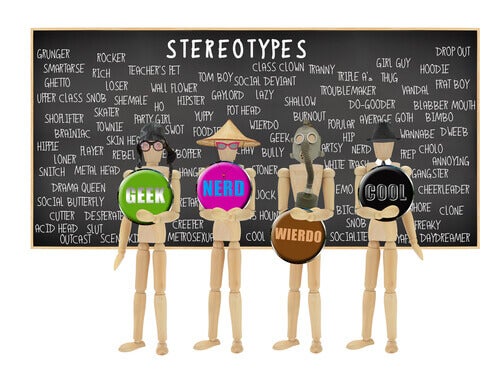The Content of a Stereotype: Sociability and Competence

The stereotypes you maintain are closely tied to the image you have of a particular group. A stereotype if a simplified impression with few specific details. You use said snapshot to judge every person in a given group as the same. You might also use it to justify certain behaviors.
Each stereotype is different and includes different characteristics. Stereotypes also tend to include two characteristics: sociability and competence.
One stereotype for Spaniards, for example, is that they love parties and flamenco. Of course, a good paella is also indispensable for them. Italians are in the mafia and all Latinos can dance well, according to some. Let’s not forget the old assumption that women are warmer and more sensitive than men. These are just a few of the most popular stereotypes.
The content of a stereotype
The model of “the content of a stereotype” postulates that all group stereotypes are created according to two dimensions. Those are sociability and competence. The model is based on the notion that people are evolutionarily predisposed to evaluating certain things. First, they tend to evaluate the intentions of strangers. They need to decide whether a stranger wants to harm them or help them. This is the dimension we call “sociability”, although some call it “warmth”. The second is the determination about the person’s capacity to act on that perceived intention. This is what we mean by “competence”.

Thus, you might consider that the groups that are competing with your own have a low level of sociability. You might treat them with hostility and contempt. On the other hand, you’d probably consider groups that are sociable to have a very high competence. This group also tends to include people with high social status. Some examples are those who have a high level of attainment, financially or educationally. Thus, when there’s no particular threat, you tend to consider others to be sociable. You use status symbols to determine a person’s competence level.
“We were a savage little lot, Liverpool kids, not pacifist or vegetarian or anything. But I feel I’ve gone beyond that, and that it was immature to be so prejudiced and believe in all the stereotypes.”
-Paul McCartney-
The sociability and competence dimensions
The stereotype content model, as you’ve seen, speaks of two dimensions people use to evaluate groups. These are sociability and competence. Groups and their members, then, can value external groups or people higher or lower on each dimension.
- Sociability. Sociability is essential since it’s going to determine relationships. If you think a person isn’t very sociable, you probably won’t try to associate with them. As you can see, (perceived) sociability depends largely on how much of a threat you think the subject is. Aside from that, sociability has a morality component. In other words, people generally consider more sociable people to be more moral.
- Competence. Those who have high status are judged as more competent than those with lower status. Nevertheless, this dimension is less important than sociability.
Behavior and emotions according to the content of the stereotype
Researchers added certain behaviors and emotions to this stereotype model. These corresponded to each one of the dimensions in the model. So people who were considered high in sociability and competence had more of a propensity to inspire admiration in others. On the other hand, people who are judged as high in sociability but low in competence are more likely to receive paternalistic treatment. The elderly usually fall into this category.
On the other side are the people who others see as unsociable but with high competence. People tend to feel jealous of them. In fact, they often become the perfect scapegoats when things go wrong. Some of the groups that people have historically treated this way are the Jews. The same goes for Asians and feminists. Finally, those who are low in both sociability and competence often elicit contempt, rejection, and dehumanizing treatment from others. One example of people in this group are the homeless.
This is how you group different social groups and the members that comprise them. Evidently, the groups that fare the worst are those that people consider to have the lowest levels of competence and sociability. Social research tells you that you try to avoid these types of people. On the other hand, you probably try to make those who have high sociability and competence part of your own group. That’s partially why there’s the phenomenon of favoritism toward people in your social group and biases against people on the outside.
“Once you label me you negate me.”
-Soren Kierkegaard-
The stereotypes you maintain are closely tied to the image you have of a particular group. A stereotype if a simplified impression with few specific details. You use said snapshot to judge every person in a given group as the same. You might also use it to justify certain behaviors.
Each stereotype is different and includes different characteristics. Stereotypes also tend to include two characteristics: sociability and competence.
One stereotype for Spaniards, for example, is that they love parties and flamenco. Of course, a good paella is also indispensable for them. Italians are in the mafia and all Latinos can dance well, according to some. Let’s not forget the old assumption that women are warmer and more sensitive than men. These are just a few of the most popular stereotypes.
The content of a stereotype
The model of “the content of a stereotype” postulates that all group stereotypes are created according to two dimensions. Those are sociability and competence. The model is based on the notion that people are evolutionarily predisposed to evaluating certain things. First, they tend to evaluate the intentions of strangers. They need to decide whether a stranger wants to harm them or help them. This is the dimension we call “sociability”, although some call it “warmth”. The second is the determination about the person’s capacity to act on that perceived intention. This is what we mean by “competence”.

Thus, you might consider that the groups that are competing with your own have a low level of sociability. You might treat them with hostility and contempt. On the other hand, you’d probably consider groups that are sociable to have a very high competence. This group also tends to include people with high social status. Some examples are those who have a high level of attainment, financially or educationally. Thus, when there’s no particular threat, you tend to consider others to be sociable. You use status symbols to determine a person’s competence level.
“We were a savage little lot, Liverpool kids, not pacifist or vegetarian or anything. But I feel I’ve gone beyond that, and that it was immature to be so prejudiced and believe in all the stereotypes.”
-Paul McCartney-
The sociability and competence dimensions
The stereotype content model, as you’ve seen, speaks of two dimensions people use to evaluate groups. These are sociability and competence. Groups and their members, then, can value external groups or people higher or lower on each dimension.
- Sociability. Sociability is essential since it’s going to determine relationships. If you think a person isn’t very sociable, you probably won’t try to associate with them. As you can see, (perceived) sociability depends largely on how much of a threat you think the subject is. Aside from that, sociability has a morality component. In other words, people generally consider more sociable people to be more moral.
- Competence. Those who have high status are judged as more competent than those with lower status. Nevertheless, this dimension is less important than sociability.
Behavior and emotions according to the content of the stereotype
Researchers added certain behaviors and emotions to this stereotype model. These corresponded to each one of the dimensions in the model. So people who were considered high in sociability and competence had more of a propensity to inspire admiration in others. On the other hand, people who are judged as high in sociability but low in competence are more likely to receive paternalistic treatment. The elderly usually fall into this category.
On the other side are the people who others see as unsociable but with high competence. People tend to feel jealous of them. In fact, they often become the perfect scapegoats when things go wrong. Some of the groups that people have historically treated this way are the Jews. The same goes for Asians and feminists. Finally, those who are low in both sociability and competence often elicit contempt, rejection, and dehumanizing treatment from others. One example of people in this group are the homeless.
This is how you group different social groups and the members that comprise them. Evidently, the groups that fare the worst are those that people consider to have the lowest levels of competence and sociability. Social research tells you that you try to avoid these types of people. On the other hand, you probably try to make those who have high sociability and competence part of your own group. That’s partially why there’s the phenomenon of favoritism toward people in your social group and biases against people on the outside.
“Once you label me you negate me.”
-Soren Kierkegaard-
This text is provided for informational purposes only and does not replace consultation with a professional. If in doubt, consult your specialist.







